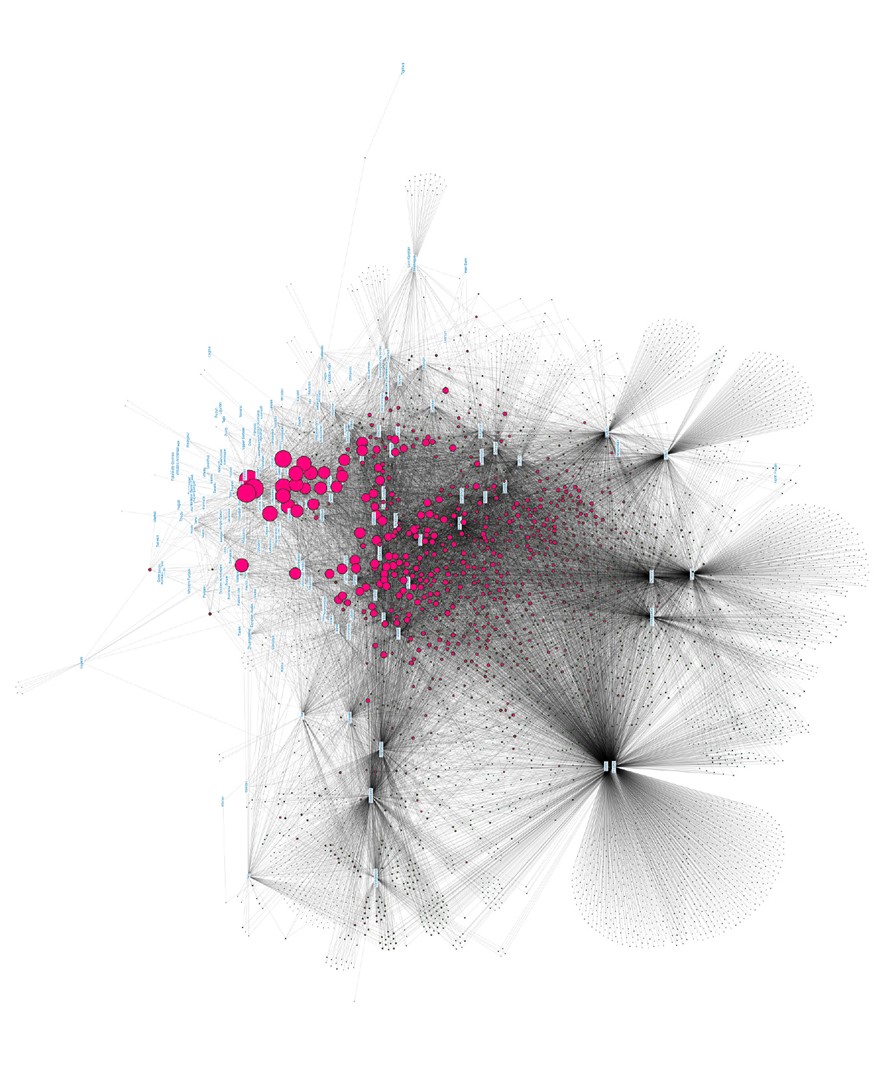Abstract
This spark explores the intermedial circulation of literary characters, examining how they gain cultural mobility through fragmentation, recontextualisation, and shifts in meaning. These characters appear across various media and contexts, often reduced to iconic traits (Pinocchio’s nose, Faust’s name) but retaining rich significance. They transcend their original narratives, becoming symbols in feminist discourse or commodity culture. Figures like Dracula and Robin Hood, or even historical personalities, are reimagined for commercial, political, or social purposes, demonstrating their dynamic and evolving roles in contemporary culture.
My stay in Berlin at EXC 2020 from March 1 to 31, 2024 was an enriching experience for my research and for the expansion of my academic network. The topics that are being researched in Research Area 5 “Building Digital Communities” are closely related to my own interest in the phenomenon of “Interfigurality”. My presentation to the members of the Research Area 5, individual meetings with Frank Fischer and Bart Soethaert, members of the working group, as well as the discussions with other fellows such as Mads Rosendahl Thomsen have furthered my reflections, encouraged new ideas, and raised a number of questions whose relevance I had not previously recognised. In particular, I was able to gain new insights into the use of Wikipedia and Wikidata as a research tool, questions of intermedial circulation and the research field of world literature. This resulted in promising intersections and possible synergies for further collaboration.
My project addresses the intermedial circulation of literary characters. It is based on the assumption that literary characters have developed forms of cultural mobility in the media system that are based on fragmentation, decontextualisation, recontextualisation, and shifts of meaning. Literary characters circulate in different media and cultures and develop a firm presence in everyday life: even when reduced to a schematised representation with few features (such as Pinocchio’s nose, the mermaid’s tail) or name (such as Shylock, Faust) they are recognisable. They can be small in appearance but dense in meaning. They can be applied in different media without their genuine—or even any—narrative context. This is seen when Sappho, Anna Karenina, or Emma Bovary are adopted as feminist icons, and even more explicitly in commodity culture where Antigone, Starbuck, or Pan Tadeusz are used as fashion brands, coffee shop, or liquor labels. In street art or commercials, characters from Anthony Burgess’s Clockwork Orange, Bram Stoker’s Dracula, or Robin Hood that are intended to advertise, to entertain, or to spread a political message stand side-by-side with authors (such as Shakespeare, Poe, or Kafka)—and also other historical persons (like Mahatma Gandhi or Mother Teresa). Some of them are given new—and sometimes surprising—functions, such as He-Man, who becomes an LGBTQI icon, or Winnie the Pooh, who becomes a symbol of resistance to Chinese President Xi Jinping.
The aim of my work is to develop a theory and associated methodology that helps us to understand and to describe what actually “happens” to literary characters when they are detached from their original narrative contexts and diffuse into media, arts, commodity culture, and digital worlds. This dissemination and circulation of characters or their fragments in a global and intermedial setting challenges the common reception-based theories because it highlights that there is not just one form of knowledge. It shows that the social imaginary—as I would like to call it—is as diverse as pluralistic societies are. Particularly with regard to character representations that have emancipated themselves from their original narrative contexts, the question of age, cultural, or educational background is crucial for the reception process: a street art representation or an internet meme lack information that would/could control or guide the meaning of the characters and facilitate understanding.
An important resource for my analyses is the collaborative knowledge platform Wikipedia because it can help us to study the “social imaginary” or “common knowledge” about literary characters. In the discussion that followed my presentation on March 7, many questions arose about working with Wikipedia and the related knowledge graph Wikidata. The issues we discussed ranged from content-related aspects concerning the representation and stereotyping of characters to practical copyright issues—all of them will inform my further work.
2536827
{2536827:I3EMHR27},{2536827:MDZY5SF7},{2536827:A4LZ3BHQ},{2536827:4QP4IB7R},{2536827:N7PWME42}
1
chicago-fullnote-bibliography
50
default
12613
https://articulations.temporal-communities.de/wp-content/plugins/zotpress/
%7B%22status%22%3A%22success%22%2C%22updateneeded%22%3Afalse%2C%22instance%22%3Afalse%2C%22meta%22%3A%7B%22request_last%22%3A0%2C%22request_next%22%3A0%2C%22used_cache%22%3Atrue%7D%2C%22data%22%3A%5B%7B%22key%22%3A%224QP4IB7R%22%2C%22library%22%3A%7B%22id%22%3A2536827%7D%2C%22meta%22%3A%7B%22creatorSummary%22%3A%22Picard%20et%20al.%22%2C%22parsedDate%22%3A%222023%22%2C%22numChildren%22%3A0%7D%2C%22bib%22%3A%22%26lt%3Bdiv%20class%3D%26quot%3Bcsl-bib-body%26quot%3B%20style%3D%26quot%3Bline-height%3A%201.35%3B%20padding-left%3A%201em%3B%20text-indent%3A-1em%3B%26quot%3B%26gt%3B%5Cn%20%20%26lt%3Bdiv%20class%3D%26quot%3Bcsl-entry%26quot%3B%26gt%3BPicard%2C%20Sophie%2C%20Paula%20Wojcik%2C%20and%20Sina%20Zarrie%26%23xDF%3B.%20%26%23x201C%3BZirkulation%20und%20Wertsch%26%23xF6%3Bpfung%20am%20Beispiel%20literarischer%20Figuren.%26%23x201D%3B%20In%20%26lt%3Bi%26gt%3BDer%20Wert%20der%20literarischen%20Zirkulation%20%5C%2F%20The%20Value%20of%20Literary%20Circulation%26lt%3B%5C%2Fi%26gt%3B%2C%20edited%20by%20Michael%20Gamper%2C%20Jutta%20M%26%23xFC%3Bller-Tamm%2C%20David%20Wachter%2C%20and%20Jasmin%20Wrobel%2C%20431%26%23×2013%3B53.%20Berlin%5C%2FHeidelberg%3A%20Springer%2C%202023.%20%26lt%3Ba%20class%3D%26%23039%3Bzp-ItemURL%26%23039%3B%20href%3D%26%23039%3Bhttps%3A%5C%2F%5C%2Fdoi.org%5C%2F10.1007%5C%2F978-3-662-65544-3_26%26%23039%3B%26gt%3Bhttps%3A%5C%2F%5C%2Fdoi.org%5C%2F10.1007%5C%2F978-3-662-65544-3_26%26lt%3B%5C%2Fa%26gt%3B.%26lt%3B%5C%2Fdiv%26gt%3B%5Cn%26lt%3B%5C%2Fdiv%26gt%3B%22%2C%22data%22%3A%7B%22itemType%22%3A%22bookSection%22%2C%22title%22%3A%22Zirkulation%20und%20Wertsch%5Cu00f6pfung%20am%20Beispiel%20literarischer%20Figuren%22%2C%22creators%22%3A%5B%7B%22creatorType%22%3A%22editor%22%2C%22firstName%22%3A%22Michael%22%2C%22lastName%22%3A%22Gamper%22%7D%2C%7B%22creatorType%22%3A%22editor%22%2C%22firstName%22%3A%22Jutta%22%2C%22lastName%22%3A%22M%5Cu00fcller-Tamm%22%7D%2C%7B%22creatorType%22%3A%22editor%22%2C%22firstName%22%3A%22David%22%2C%22lastName%22%3A%22Wachter%22%7D%2C%7B%22creatorType%22%3A%22editor%22%2C%22firstName%22%3A%22Jasmin%22%2C%22lastName%22%3A%22Wrobel%22%7D%2C%7B%22creatorType%22%3A%22author%22%2C%22firstName%22%3A%22Sophie%22%2C%22lastName%22%3A%22Picard%22%7D%2C%7B%22creatorType%22%3A%22author%22%2C%22firstName%22%3A%22Paula%22%2C%22lastName%22%3A%22Wojcik%22%7D%2C%7B%22creatorType%22%3A%22author%22%2C%22firstName%22%3A%22Sina%22%2C%22lastName%22%3A%22Zarrie%5Cu00df%22%7D%5D%2C%22abstractNote%22%3A%22%22%2C%22bookTitle%22%3A%22Der%20Wert%20der%20literarischen%20Zirkulation%20%5C%2F%20The%20Value%20of%20Literary%20Circulation%22%2C%22date%22%3A%222023%22%2C%22language%22%3A%22de%22%2C%22ISBN%22%3A%22978-3-662-65543-6%20978-3-662-65544-3%22%2C%22url%22%3A%22https%3A%5C%2F%5C%2Fdoi.org%5C%2F10.1007%5C%2F978-3-662-65544-3_26%22%2C%22collections%22%3A%5B%5D%2C%22dateModified%22%3A%222024-10-08T10%3A25%3A23Z%22%7D%7D%2C%7B%22key%22%3A%22N7PWME42%22%2C%22library%22%3A%7B%22id%22%3A2536827%7D%2C%22meta%22%3A%7B%22creatorSummary%22%3A%22Wojcik%20et%20al.%22%2C%22parsedDate%22%3A%222023-05-11%22%2C%22numChildren%22%3A0%7D%2C%22bib%22%3A%22%26lt%3Bdiv%20class%3D%26quot%3Bcsl-bib-body%26quot%3B%20style%3D%26quot%3Bline-height%3A%201.35%3B%20padding-left%3A%201em%3B%20text-indent%3A-1em%3B%26quot%3B%26gt%3B%5Cn%20%20%26lt%3Bdiv%20class%3D%26quot%3Bcsl-entry%26quot%3B%26gt%3BWojcik%2C%20Paula%2C%20Bastian%20Bunzeck%2C%20and%20Sina%20Zarrie%26%23xDF%3B.%20%26%23x201C%3BThe%20Wikipedia%20Republic%20of%20Literary%20Characters.%26%23x201D%3B%20%26lt%3Bi%26gt%3BJournal%20of%20Cultural%20Analytics%26lt%3B%5C%2Fi%26gt%3B%208%2C%20no.%202%20%28May%2011%2C%202023%29.%20%26lt%3Ba%20class%3D%26%23039%3Bzp-ItemURL%26%23039%3B%20href%3D%26%23039%3Bhttps%3A%5C%2F%5C%2Fculturalanalytics.org%5C%2Farticle%5C%2F70251-the-wikipedia-republic-of-literary-characters%26%23039%3B%26gt%3Bhttps%3A%5C%2F%5C%2Fculturalanalytics.org%5C%2Farticle%5C%2F70251-the-wikipedia-republic-of-literary-characters%26lt%3B%5C%2Fa%26gt%3B.%26lt%3B%5C%2Fdiv%26gt%3B%5Cn%26lt%3B%5C%2Fdiv%26gt%3B%22%2C%22data%22%3A%7B%22itemType%22%3A%22journalArticle%22%2C%22title%22%3A%22The%20Wikipedia%20Republic%20of%20Literary%20Characters%22%2C%22creators%22%3A%5B%7B%22creatorType%22%3A%22author%22%2C%22firstName%22%3A%22Paula%22%2C%22lastName%22%3A%22Wojcik%22%7D%2C%7B%22creatorType%22%3A%22author%22%2C%22firstName%22%3A%22Bastian%22%2C%22lastName%22%3A%22Bunzeck%22%7D%2C%7B%22creatorType%22%3A%22author%22%2C%22firstName%22%3A%22Sina%22%2C%22lastName%22%3A%22Zarrie%5Cu00df%22%7D%5D%2C%22abstractNote%22%3A%22Literary%20characters%20do%20not%20receive%20the%20same%20attention%20from%20literary%20scholars%20as%20other%20components%20of%20literature%20%28i.e.%5Cu00a0the%20narrative%2C%20theme%2C%20motif%29.%20In%20contrast%20to%20this%20lack%20of%20interest%2C%20various%20studies%20have%20shown%20that%20characters%20in%20particular%20play%20an%20important%20role%20for%20readers.%20We%20draw%20on%20this%20observation%20to%20explore%20a%20user-oriented%20notion%20of%20World%20Literature%20according%20to%20the%20collaborative%20encyclopedia%20Wikipedia.%20Based%20on%20its%20language-independent%20taxonomy%20Wikidata%2C%20we%20collect%20data%20from%20321%20Wikipedia%20editions%20on%20more%20than%207000%20characters%20presented%20on%20more%20than%2019000%20independent%20character%20pages%20across%20the%20various%20language%20editions.%20We%20use%20this%20data%20to%20build%20a%20network%20that%20represents%20affiliations%20of%20characters%20to%20Wikipedia%20languages%2C%20which%20leads%20us%20to%20question%20some%20of%20the%20established%20presumptions%20towards%20key-concepts%20in%20World%20Literature%20studies%20such%20as%20the%20notion%20of%20major%20and%20minor%2C%20the%20center-periphery%20opposition%20or%20the%20canon.%22%2C%22date%22%3A%222023-5-11%22%2C%22language%22%3A%22en%22%2C%22DOI%22%3A%22%22%2C%22ISSN%22%3A%222371-4549%22%2C%22url%22%3A%22https%3A%5C%2F%5C%2Fculturalanalytics.org%5C%2Farticle%5C%2F70251-the-wikipedia-republic-of-literary-characters%22%2C%22collections%22%3A%5B%5D%2C%22dateModified%22%3A%222024-10-04T13%3A31%3A02Z%22%7D%7D%2C%7B%22key%22%3A%22I3EMHR27%22%2C%22library%22%3A%7B%22id%22%3A2536827%7D%2C%22meta%22%3A%7B%22creatorSummary%22%3A%22Eder%20et%20al.%22%2C%22parsedDate%22%3A%222010%22%2C%22numChildren%22%3A0%7D%2C%22bib%22%3A%22%26lt%3Bdiv%20class%3D%26quot%3Bcsl-bib-body%26quot%3B%20style%3D%26quot%3Bline-height%3A%201.35%3B%20padding-left%3A%201em%3B%20text-indent%3A-1em%3B%26quot%3B%26gt%3B%5Cn%20%20%26lt%3Bdiv%20class%3D%26quot%3Bcsl-entry%26quot%3B%26gt%3BEder%2C%20Jens%2C%20Fotis%20Jannidis%2C%20and%20Ralf%20Schneider%2C%20eds.%20%26lt%3Bi%26gt%3BCharacters%20in%20Fictional%20Worlds%3A%20Understanding%20Imaginary%20Beings%20in%20Literature%2C%20Film%2C%20and%20Other%20Media%26lt%3B%5C%2Fi%26gt%3B.%20Berlin%5C%2FNew%20York%3A%20De%20Gruyter%2C%202010.%26lt%3B%5C%2Fdiv%26gt%3B%5Cn%26lt%3B%5C%2Fdiv%26gt%3B%22%2C%22data%22%3A%7B%22itemType%22%3A%22book%22%2C%22title%22%3A%22Characters%20in%20fictional%20worlds%3A%20understanding%20imaginary%20beings%20in%20literature%2C%20film%2C%20and%20other%20media%22%2C%22creators%22%3A%5B%7B%22creatorType%22%3A%22editor%22%2C%22firstName%22%3A%22Jens%22%2C%22lastName%22%3A%22Eder%22%7D%2C%7B%22creatorType%22%3A%22editor%22%2C%22firstName%22%3A%22Fotis%22%2C%22lastName%22%3A%22Jannidis%22%7D%2C%7B%22creatorType%22%3A%22editor%22%2C%22firstName%22%3A%22Ralf%22%2C%22lastName%22%3A%22Schneider%22%7D%5D%2C%22abstractNote%22%3A%22%22%2C%22date%22%3A%222010%22%2C%22language%22%3A%22en%22%2C%22ISBN%22%3A%22978-3-11-023241-7%22%2C%22url%22%3A%22%22%2C%22collections%22%3A%5B%5D%2C%22dateModified%22%3A%222024-10-04T13%3A16%3A57Z%22%7D%7D%2C%7B%22key%22%3A%22MDZY5SF7%22%2C%22library%22%3A%7B%22id%22%3A2536827%7D%2C%22meta%22%3A%7B%22creatorSummary%22%3A%22Eco%22%2C%22parsedDate%22%3A%222009-01%22%2C%22numChildren%22%3A0%7D%2C%22bib%22%3A%22%26lt%3Bdiv%20class%3D%26quot%3Bcsl-bib-body%26quot%3B%20style%3D%26quot%3Bline-height%3A%201.35%3B%20padding-left%3A%201em%3B%20text-indent%3A-1em%3B%26quot%3B%26gt%3B%5Cn%20%20%26lt%3Bdiv%20class%3D%26quot%3Bcsl-entry%26quot%3B%26gt%3BEco%2C%20Umberto.%20%26%23x201C%3BOn%20the%20Ontology%20of%20Fictional%20Characters%3A%20A%20Semiotic%20Approach.%26%23x201D%3B%20%26lt%3Bi%26gt%3BSign%20Systems%20Studies%26lt%3B%5C%2Fi%26gt%3B%2037%2C%20no.%201%26%23×2013%3B2%20%28January%202009%29%3A%2082%26%23×2013%3B98.%20%26lt%3Ba%20class%3D%26%23039%3Bzp-ItemURL%26%23039%3B%20href%3D%26%23039%3Bhttps%3A%5C%2F%5C%2Fdoi.org%5C%2F10.12697%5C%2FSSS.2009.37.1-2.04%26%23039%3B%26gt%3Bhttps%3A%5C%2F%5C%2Fdoi.org%5C%2F10.12697%5C%2FSSS.2009.37.1-2.04%26lt%3B%5C%2Fa%26gt%3B.%26lt%3B%5C%2Fdiv%26gt%3B%5Cn%26lt%3B%5C%2Fdiv%26gt%3B%22%2C%22data%22%3A%7B%22itemType%22%3A%22journalArticle%22%2C%22title%22%3A%22On%20the%20ontology%20of%20fictional%20characters%3A%20A%20semiotic%20approach%22%2C%22creators%22%3A%5B%7B%22creatorType%22%3A%22author%22%2C%22firstName%22%3A%22Umberto%22%2C%22lastName%22%3A%22Eco%22%7D%5D%2C%22abstractNote%22%3A%22Why%20are%20we%20deeply%20moved%20by%20the%20misfortune%20of%20Anna%20Karenina%20if%20we%20are%20fully%20aware%20that%20she%20is%20simply%20a%20fictional%20character%20who%20does%20not%20exist%20in%20our%20world%3F%20But%20what%20does%20it%20mean%20that%20fictional%20characters%20do%20not%20exist%3F%20The%20present%20article%20is%20concerned%20with%20the%20ontology%20of%20fictional%20characters.%20The%20author%20concludes%20that%20successful%20fictional%20characters%20become%20paramount%20examples%20of%20the%20%26%23039%3Breal%26%23039%3B%20human%20condition%20because%20they%20live%20in%20an%20incomplete%20world%20what%20we%20have%20cognitive%20access%20to%20but%20cannot%20influence%20in%20any%20way%20and%20where%20no%20deeds%20can%20be%20undone.%20Unlike%20all%20the%20other%20semiotic%20objects%2C%20which%20are%20culturally%20subject%20to%20revisions%2C%20and%20perhaps%20only%20similar%20to%20mathematical%20entities%2C%20the%20fictual%20characters%20will%20never%20change%20and%20will%20remain%20the%20actors%20of%20what%20they%20did%20once%20and%20forever.%20%28English%29%22%2C%22date%22%3A%222009-01%22%2C%22language%22%3A%22en%22%2C%22DOI%22%3A%22%22%2C%22ISSN%22%3A%2214064243%22%2C%22url%22%3A%22https%3A%5C%2F%5C%2Fdoi.org%5C%2F10.12697%5C%2FSSS.2009.37.1-2.04%22%2C%22collections%22%3A%5B%5D%2C%22dateModified%22%3A%222024-10-04T13%3A16%3A52Z%22%7D%7D%2C%7B%22key%22%3A%22A4LZ3BHQ%22%2C%22library%22%3A%7B%22id%22%3A2536827%7D%2C%22meta%22%3A%7B%22creatorSummary%22%3A%22Leschke%22%2C%22parsedDate%22%3A%222010%22%2C%22numChildren%22%3A1%7D%2C%22bib%22%3A%22%26lt%3Bdiv%20class%3D%26quot%3Bcsl-bib-body%26quot%3B%20style%3D%26quot%3Bline-height%3A%201.35%3B%20padding-left%3A%201em%3B%20text-indent%3A-1em%3B%26quot%3B%26gt%3B%5Cn%20%20%26lt%3Bdiv%20class%3D%26quot%3Bcsl-entry%26quot%3B%26gt%3BLeschke%2C%20Rainer.%20%26%23x201C%3BDie%20Figur%20als%20mediale%20Form.%20%26%23xDC%3Bberlegungen%20zur%20Funktion%20der%20Figur%20in%20den%20Medien.%26%23x201D%3B%20In%20%26lt%3Bi%26gt%3BFormen%20der%20Figur%3A%20Figurenkonzepte%20in%20K%26%23xFC%3Bnsten%20und%20Medien%26lt%3B%5C%2Fi%26gt%3B%2C%20edited%20by%20Rainer%20Leschke%20and%20Henriette%20Heidbrink%2C%2029%26%23×2013%3B49.%20Konstanz%3A%20UVK%2C%202010.%26lt%3B%5C%2Fdiv%26gt%3B%5Cn%26lt%3B%5C%2Fdiv%26gt%3B%22%2C%22data%22%3A%7B%22itemType%22%3A%22bookSection%22%2C%22title%22%3A%22Die%20Figur%20als%20mediale%20Form.%20%5Cu00dcberlegungen%20zur%20Funktion%20der%20Figur%20in%20den%20Medien%22%2C%22creators%22%3A%5B%7B%22creatorType%22%3A%22editor%22%2C%22firstName%22%3A%22Rainer%22%2C%22lastName%22%3A%22Leschke%22%7D%2C%7B%22creatorType%22%3A%22editor%22%2C%22firstName%22%3A%22Henriette%22%2C%22lastName%22%3A%22Heidbrink%22%7D%2C%7B%22creatorType%22%3A%22author%22%2C%22firstName%22%3A%22Rainer%22%2C%22lastName%22%3A%22Leschke%22%7D%5D%2C%22abstractNote%22%3A%22%22%2C%22bookTitle%22%3A%22Formen%20der%20Figur%3A%20Figurenkonzepte%20in%20K%5Cu00fcnsten%20und%20Medien%22%2C%22date%22%3A%222010%22%2C%22language%22%3A%22de%22%2C%22ISBN%22%3A%22978-3-86764-086-2%22%2C%22url%22%3A%22%22%2C%22collections%22%3A%5B%5D%2C%22dateModified%22%3A%222024-10-04T13%3A16%3A40Z%22%7D%7D%5D%7D
Picard, Sophie, Paula Wojcik, and Sina Zarrieß. “Zirkulation und Wertschöpfung am Beispiel literarischer Figuren.” In
Der Wert der literarischen Zirkulation / The Value of Literary Circulation, edited by Michael Gamper, Jutta Müller-Tamm, David Wachter, and Jasmin Wrobel, 431–53. Berlin/Heidelberg: Springer, 2023.
https://doi.org/10.1007/978-3-662-65544-3_26.
Wojcik, Paula, Bastian Bunzeck, and Sina Zarrieß. “The Wikipedia Republic of Literary Characters.”
Journal of Cultural Analytics 8, no. 2 (May 11, 2023).
https://culturalanalytics.org/article/70251-the-wikipedia-republic-of-literary-characters.
Eder, Jens, Fotis Jannidis, and Ralf Schneider, eds. Characters in Fictional Worlds: Understanding Imaginary Beings in Literature, Film, and Other Media. Berlin/New York: De Gruyter, 2010.
Eco, Umberto. “On the Ontology of Fictional Characters: A Semiotic Approach.”
Sign Systems Studies 37, no. 1–2 (January 2009): 82–98.
https://doi.org/10.12697/SSS.2009.37.1-2.04.
Leschke, Rainer. “Die Figur als mediale Form. Überlegungen zur Funktion der Figur in den Medien.” In Formen der Figur: Figurenkonzepte in Künsten und Medien, edited by Rainer Leschke and Henriette Heidbrink, 29–49. Konstanz: UVK, 2010.




